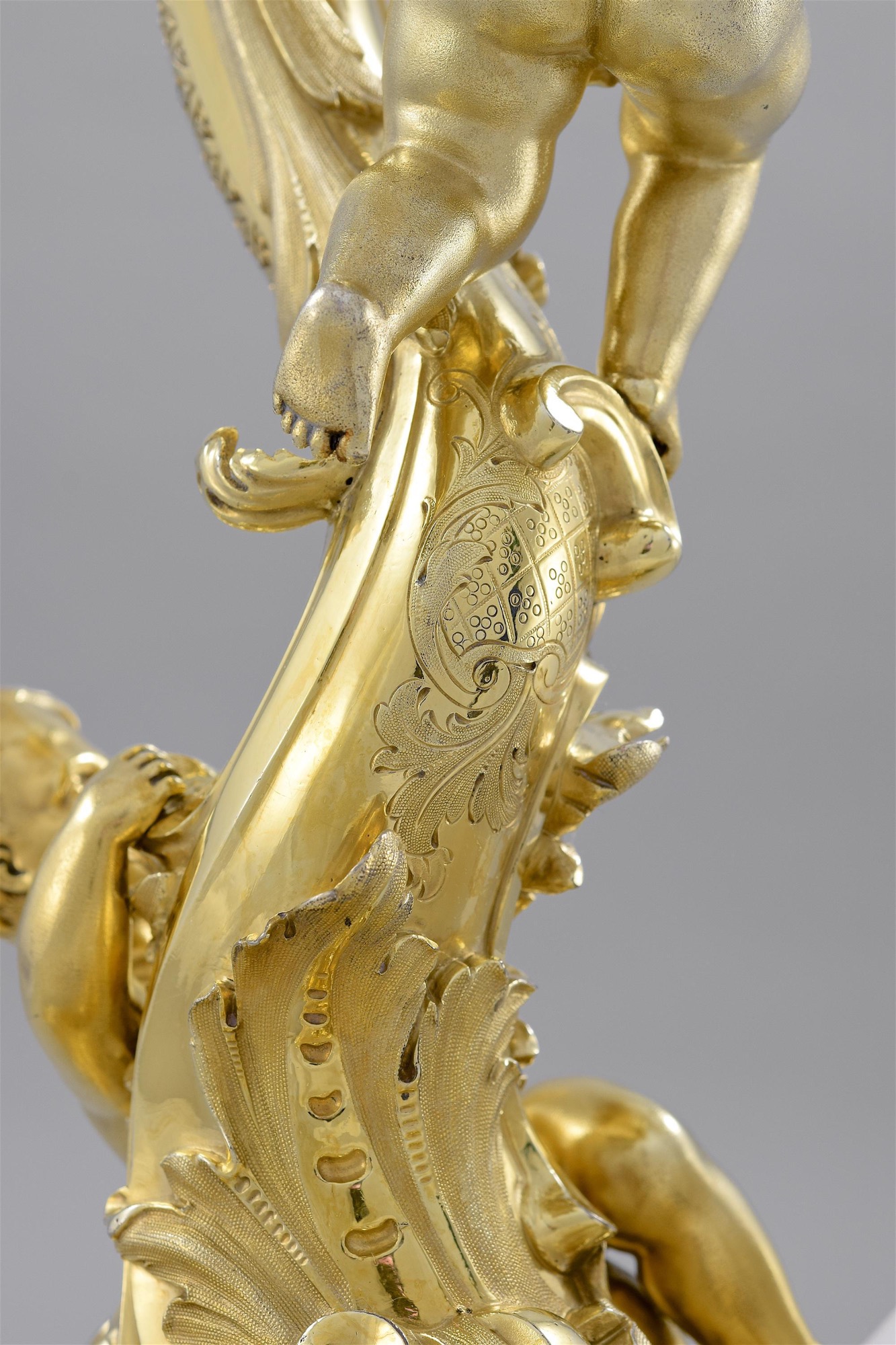An important pair of William IV antique silver-gilt six-light candelabra from the Pembroke Service.
An important pair of William IV antique silver-gilt six-light candelabra from the Pembroke Service.
By Paul Storr, London 1835, each engraved 'Published as the Act directs by Storr and Mortimer 156 New Bond Street, London Octr 15, 1835. Nr 42'
In the Rococo revival style, supported on an openwork triform base with cyphers and coronet integrated into the design for the Earl of Pembroke,
Height 76.5cm,
weight together 691oz (21517g)
Provenance
Robert Henry Herbert, 12th Earl of Pembroke and 9th Earl of Montgomery (1791 -1862)
Christie and Manson, Catalogue of the magnificent contents of the mansion of
...
By Paul Storr, London 1835, each engraved 'Published as the Act directs by Storr and Mortimer 156 New Bond Street, London Octr 15, 1835. Nr 42'
In the Rococo revival style, supported on an openwork triform base with cyphers and coronet integrated into the design for the Earl of Pembroke,
Height 76.5cm,
weight together 691oz (21517g)
Provenance
Robert Henry Herbert, 12th Earl of Pembroke and 9th Earl of Montgomery (1791 -1862)
Christie and Manson, Catalogue of the magnificent contents of the mansion of
the Right Hon. the Earl of Pembroke... 7, Carlton House Terrace, London, 5th May 1851, lots 75 and 76.
Robert Henry Herbert, 12th Earl of Pembroke and 9th Earl of Montgomery (1791 -1862) was the eldest surviving son of the 11th Earl of Pembroke and Elizabeth Beauclerk, a great-great-granddaughter of Charles II. He spent his childhood at Wilton House, Wiltshire, the seat of the Earls of Pembroke since 1551. After his education at Harrow he travelled to Sicily where in 1814 he entered into marriage against his father's wishes with the recently widowed wife of Prince Ercole Branciforte di Butera, who had died only a month and a half before. On the grounds that it had been a clandestine marriage the 11th Earl compelled the authorities in Palermo to separate the couple, and managed to persuade his son to abandon the princess and return to England.
On his father's death in 1827, the 12th Earl succeeded to the title and took his seat in the House of Lords in 1833. Taking no interest in these duties, he soon left for Paris where he lived in a residence at 19 Place Vendôme, which he fitted out in the 18th century French style and with unreserved opulence. Here he entered into a relationship with the ballet dancer Elisa Sheffer with whom he had four illegitimate children, while at the same time, during his frequent trips to London, siring a further three illegitimate children with another woman, all of whom he provided generously for in his will. His obituary described him favourably: 'His person, his manners, his dress, belonged rather to the elegant school of the best days of George III... brilliant and distinguished in society, he maintained to the last the reputation of a man of elegance and fashion.
¨The Pembroke Service" A subject of general conversation among the upper classes, at the moment, is a splendid service of plate, for thirty persons, just arrived at Paris, belonging to the Earl of Pembroke, and which a privileged few have been permitted to view at his Lordship's residence. Its weight is 630 pounds French, and it cost upwards of 700,000f.; one piece, a candelabrum, is estimated at 40,000f. Its manufacture occupied three years. Nothing can exceed the beauty and delicacy of the chasing, and the engraving of his lordship's arms displays the most skilful workmanship. So ran a newspaper article in December 1835. However, the weight given here accounts for only part of the Earl's service which was described as weighing 370 kilos in the 1862 sale catalogue of the contents of his Paris home which took place shortly after his death. Even this figure does not account for the entirety of the service: the pieces kept at his London residence at 7 Carlton House Terrace, where he resided during his trips to London from 1846-1851, add to the total substantially. These pieces came up for sale during the Earl's lifetime when he sold the mansion in 1851. It was this sale that included these candelabra, sold as two lots and described as 'A very handsome candelabrum, with twisting stem, surrounded by foliage, up which two boys are climbing; on a tripod openwork scroll stand, with branches for six lights, surmounted by a griffin - 31in. high.' and 'The companion candelabrum'. The hallmarks on the forty-five or so pieces that have surfaced in the past forty years range from 1828 - 1837, showing that the creation of the service was a particularly lengthy affair and must rank as one of Storr's largest.
The grandest piece from the Pembroke service is the nine-light candelabrum, now in the Metropolitan Museum of Art, New York. It featured as the first lot in the 1862 Paris sale, and was described as 'a piece of goldsmith's work in the most beautiful style and of remarkable execution'. Astonishingly, this catalogue also reveals that the candelabrum could be augmented to twenty-seven lights by means of ormolu branches, sold in the same lot but now seemingly lost. The pair of candelabra are almost identical in overall form to the larger candelabrum. They fit in well with the Earl's taste for French rococo style, and may well have been intended to sit either side of the nine-light example. The design is a riot of movement and energy, defying the viewer to focus on one particular area. Almost inevitably, the eye is drawn upwards to the wyverns perched majestically above the turmoil below. Some order is lent by the clever way the asymmetrical scrolls are positioned symmetrically opposite each other, and the subtle use of contrasting smooth, matte and heavily textured surfaces which allow each element to stand out on its own rather than blurring into the whole.
10883
Dimensions



















